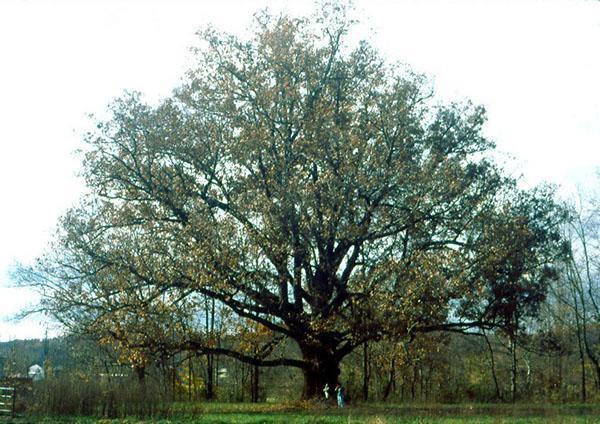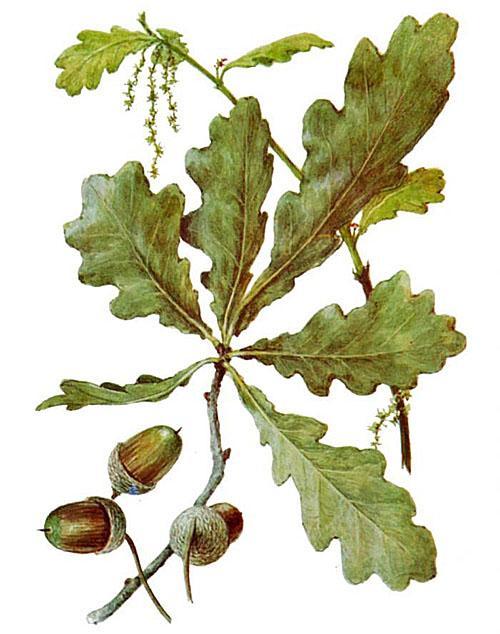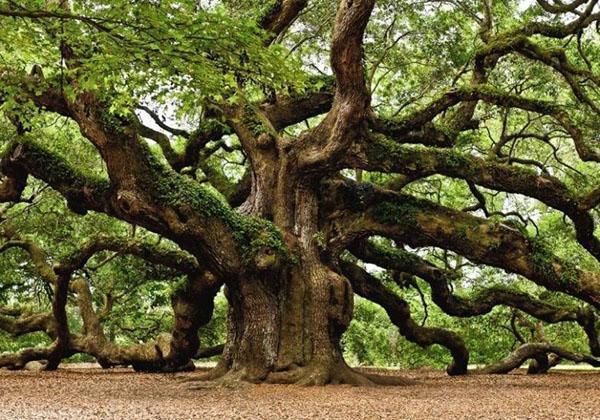Mighty and great oak
 Great height, power, greatness. This is how the oak is described in ancient legends. Representatives of the genus grow in many parts of our Earth, but the most interesting and ancient specimens are located on the territory of the Russian Federation. In places with ideal conditions for their development.
Great height, power, greatness. This is how the oak is described in ancient legends. Representatives of the genus grow in many parts of our Earth, but the most interesting and ancient specimens are located on the territory of the Russian Federation. In places with ideal conditions for their development.
Description

Regardless of the species, all trees have common features. The height ranges from 35 to 50 m. Some specimens reach 60 m. The trunk is very thick, and its bark is rough and covered with deep cracks.
You can determine the type of tree by the shape of the leaves (for example, toothed, lobed, pinnate) and different colors.
It is remarkable how the oak looks in autumn. The usual green summer foliage changes to "clothes" of red, purple, orange, brown, yellow tones.
The tree reacts strongly to light. Its branches are twisting, because they stretch towards the light and change their direction depending on weather conditions.
As for the root system, it is as powerful and well developed as the aboveground part and goes deep into the soil. Giants prefer to grow on nutritious soils. In this case, the humidity should be moderate. But there are representatives who have chosen swampy or arid places.
Flowering occurs in late spring with the dissolution of small bisexual green flowers. Moreover, female flowers contain only a pistil, male flowers (gather in inflorescences) - only stamens. Pollination occurs with the participation of insects or wind.
After flowering, a fruit is formed - an acorn of different lengths with a cap, the so-called plyuska. By the shape of the fruit and the appearance of the plyus, the variety of the oak is determined.
Age and color
 Oaks live the longest. On average, the life span of an oak reaches 300-500 years. But there are some specimens that survive to 2000 years. For the first 150 years, the tree gains height, and after that it gains width. Therefore, according to the diameter of the trunk, they calculate how many years the oak has lived. The oldest is the Stelmuzh oak, which grows in Lithuania and is 1,500 years old with a height of 23 m and a diameter of 4 m.
Oaks live the longest. On average, the life span of an oak reaches 300-500 years. But there are some specimens that survive to 2000 years. For the first 150 years, the tree gains height, and after that it gains width. Therefore, according to the diameter of the trunk, they calculate how many years the oak has lived. The oldest is the Stelmuzh oak, which grows in Lithuania and is 1,500 years old with a height of 23 m and a diameter of 4 m.
Main types
The number of oak species all over the world is enormous. According to various sources, their number ranges from 450-600.
Russian varieties
Consider the varieties of oaks that most often grow in the Russian regions.
Petiolate oak
 In addition to the Russian Federation, the species can also be found in Western European countries. And it is he who is a long-liver. Among the distinctive features are: resistance to winds, prolonged drought and large temperature extremes.
In addition to the Russian Federation, the species can also be found in Western European countries. And it is he who is a long-liver. Among the distinctive features are: resistance to winds, prolonged drought and large temperature extremes.
Specimens growing singly, as they say "in the field", reach up to 50 m in height. But in the vicinity of other oaks, their height is somewhat lower. In addition, due to its light-loving nature, the crown formed by foliage 15 cm in length is located at the top of the trunk. For soils, trees prefer fertile land.
Chestnut oak
 It is very difficult to find a variety on the territory of Russia, only in artificially created parks and deciduous forests, since as a result of uncontrolled felling for construction, the plant is listed in the Red Book.Distinctive features are a long trunk, reaching 30 m in length, at the top of which is a tent-shaped crown with triangular leaves and pointed edges.
It is very difficult to find a variety on the territory of Russia, only in artificially created parks and deciduous forests, since as a result of uncontrolled felling for construction, the plant is listed in the Red Book.Distinctive features are a long trunk, reaching 30 m in length, at the top of which is a tent-shaped crown with triangular leaves and pointed edges.
The special value of the tree lies in wood of increased hardness and frost resistance.
Large anthered oak
 There is a variety in the south of the Caucasus in mountainous regions. Most often in artificial parks. The tree develops very slowly in height. The crown is formed by short leaves with blunt lobes. The length of the foliage reaches 8 cm. The plant is very fond of light, has a high resistance to frost and dry weather.
There is a variety in the south of the Caucasus in mountainous regions. Most often in artificial parks. The tree develops very slowly in height. The crown is formed by short leaves with blunt lobes. The length of the foliage reaches 8 cm. The plant is very fond of light, has a high resistance to frost and dry weather.
Mongolian
 The tree is very attractive in appearance. For its decorativeness, oak has received recognition from designers.
The tree is very attractive in appearance. For its decorativeness, oak has received recognition from designers.
As a rule, it is planted in plots as a tapeworm or in alleys in the form of an array. The plant develops well in partial shade. A distinctive feature of the variety is foliage. It has an elongated shape and grows up to 20 cm in length. The color of the crown is also interesting. In summer it is dark green. But with the arrival of leaf fall, its color changes to bright brown.
Hartvis Oak
 It is also known as the Armenian oak. His homeland is the western part of the Caucasus. The plant loves to grow in humid, moderately shaded areas with fertile land and a fairly warm environment.
It is also known as the Armenian oak. His homeland is the western part of the Caucasus. The plant loves to grow in humid, moderately shaded areas with fertile land and a fairly warm environment.
It is because of the conditions and climate where the oak grows that its existence is impossible in cold areas. In addition, he does not tolerate winter very well.
The foliage is obovate with semi-oval lobes. After flowering, acorns form on the long stalks.
Mediterranean and Europe
In these regions, no less interesting specimens grow.
Suberic

This variety is a valuable corknose, reaches 20 m in height, grows slowly and belongs to an evergreen. Mostly grows in squares and alleys. Despite the fact that the plant loves moisture, it is resistant to drought. The crown is formed from oval-shaped leaves up to 6 cm long. In addition, they have a fluffy substrate and a shiny surface. The fruit is represented by a small acorn strongly seated in a plyus.
Rocky
 This is the main array of parks and forests. The plant is shade and thermophilic, prefers to grow in places with moderate humidity. Foliage possesses distinctive features. It is located on petioles 2 cm long. Female oak flowers are located on a short stalk. The same goes for acorns.
This is the main array of parks and forests. The plant is shade and thermophilic, prefers to grow in places with moderate humidity. Foliage possesses distinctive features. It is located on petioles 2 cm long. Female oak flowers are located on a short stalk. The same goes for acorns.
Fluffy oak
 This specimen looks like a tall bush, reaching a height of 10 m. It prefers to grow on dry and limestone lands, and in the natural environment. Therefore, it is almost impossible to grow it. If the oak and using in landscape compositions, then as a background. The tree lends itself well to shearing, you can shape the crown at your own discretion.
This specimen looks like a tall bush, reaching a height of 10 m. It prefers to grow on dry and limestone lands, and in the natural environment. Therefore, it is almost impossible to grow it. If the oak and using in landscape compositions, then as a background. The tree lends itself well to shearing, you can shape the crown at your own discretion.
The name of the oak came from its appearance: everything from branches and foliage to acorns is covered with felt down.
America
In the American regions, the species is represented by the following specimens.
Red oak
 A very beautiful representative, remarkable not only for its size (it reaches a height of 30-50 m and a diameter of up to 1 m).
A very beautiful representative, remarkable not only for its size (it reaches a height of 30-50 m and a diameter of up to 1 m).
The oak has a very beautiful crown coloration. At the time of dissolution, the foliage has a red base. In summer, its color is bright green. But with the onset of autumn, it changes to bright brown or crimson.
It is for its bright appearance that oak has become often used in landscape design. All other characteristics are similar to ordinary Russian copies.
Northern
 It is otherwise known as boreal. His homeland is the regions of North America. The oak is similar in appearance to the “red” variety. The crown and leaves are ovoid. The leaves grow up to 25 cm in length and turn beautiful bright red with the onset of autumn. The only difference is the barrel.It does not crack and coarse so much, therefore it looks somewhat smoother than other oak trees. For its beauty, the plant is most often planted in park areas.
It is otherwise known as boreal. His homeland is the regions of North America. The oak is similar in appearance to the “red” variety. The crown and leaves are ovoid. The leaves grow up to 25 cm in length and turn beautiful bright red with the onset of autumn. The only difference is the barrel.It does not crack and coarse so much, therefore it looks somewhat smoother than other oak trees. For its beauty, the plant is most often planted in park areas.
Stone oak
 This variety has its own characteristics:
This variety has its own characteristics:
- it is an evergreen plant;
- has a large trunk around the circumference, all cut with cracks;
- the bark is gray;
- spreading crown, with infrequent branches;
- foliage is small, up to 8 cm long;
- a distinctive feature - a white or yellow substrate, in some cases covered with a pile;
- you can form a crown;
- has its own subspecies.
In addition, the plant is completely undemanding to light and can grow on any soil.
Large oak
 This specimen prefers wet places, so it can be found near water bodies or in rainy regions. You can find out by the wedge-shaped leaves of an elongated shape and having 5 pairs of blades. In spring, the blossoming foliage is colored silvery. It seems to have some kind of dusting on it. Subsequently, the color changes to a rich green with shine. In this case, the underside whitens slightly. The oak got its name for its fruits. Its acorns are very large (about 5 cm long) and are located on short stalks. The strip covers the fruit halfway.
This specimen prefers wet places, so it can be found near water bodies or in rainy regions. You can find out by the wedge-shaped leaves of an elongated shape and having 5 pairs of blades. In spring, the blossoming foliage is colored silvery. It seems to have some kind of dusting on it. Subsequently, the color changes to a rich green with shine. In this case, the underside whitens slightly. The oak got its name for its fruits. Its acorns are very large (about 5 cm long) and are located on short stalks. The strip covers the fruit halfway.
Willow
 Looking at the tree, you might think that in front of you is a willow. The fact is that the plant has an unusual leaf shape for all oaks. It is oblong, narrow and reaches a length of 12 cm. In autumn, the foliage acquires a matte yellow color. The plant has no requirements for habitat and soil. Often found in deciduous forests and planted in parks.
Looking at the tree, you might think that in front of you is a willow. The fact is that the plant has an unusual leaf shape for all oaks. It is oblong, narrow and reaches a length of 12 cm. In autumn, the foliage acquires a matte yellow color. The plant has no requirements for habitat and soil. Often found in deciduous forests and planted in parks.
White oak

The homeland of the variety is the eastern regions. The plant, in principle, has no land requirements, but grows best on nutritious, limestone and well-drained plants. Its dimensions reach 30 m in height. The crown is spreading, powerful, tent-shaped, formed by oblong-oval leaves. The latter have up to 9 "blunt" blades and grow up to 22 cm in length.
The color of the crown is unusually beautiful. Immediately after dissolution, it is bright red. With the arrival of summer, it transforms into bright green above and whitish-gray below. And in the fall, the foliage turns purple-purple or dark red. The trunk is covered with light gray bark, which does not crack much. After flowering, acorns up to 2.5 cm in length are formed, hidden by ¼ by a plyus. The plant tolerates drought well, somewhat sensitive to frost. Developing well. Often planted in alleys. Can grow alone or in a group with other trees.
Swamp oak
 The "giant" grows in the eastern zone of North America. Prefers "wet" soil with poor drainage, loam, clay soils (unacceptable substrate and high concentration of lime). Therefore, it can often be found along river banks, streams, and wet meadows. Oak loves warmth, prefers to grow in sunny places, normally belongs to partial shade, tolerates frost and wind well. Looks good in alleys or in the vicinity of other trees.
The "giant" grows in the eastern zone of North America. Prefers "wet" soil with poor drainage, loam, clay soils (unacceptable substrate and high concentration of lime). Therefore, it can often be found along river banks, streams, and wet meadows. Oak loves warmth, prefers to grow in sunny places, normally belongs to partial shade, tolerates frost and wind well. Looks good in alleys or in the vicinity of other trees.
The plant grows very slowly, reaching 25 m in height and 10-15 in width. The crown is pyramidal. The trunk is covered with light green bark, which remains smooth for a long time. The foliage grows up to 12 cm long and has several well-defined lobes. The color of the leaves is bright green, and the underside is somewhat lighter. Hairiness is observed near the corners of the veins. In autumn, the color changes to bright purple. The fruit is represented by a small acorn (up to 1.5 cm), one third hidden by a plyus.